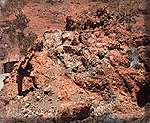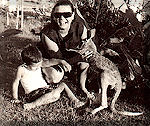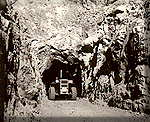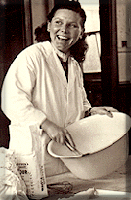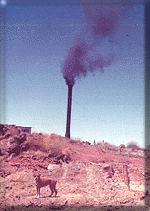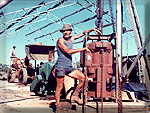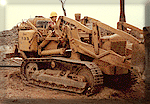|
MINING IN NORTH WEST QUEENSLAND
Alan and Brian Speechley's first introduction to small time mining in the rugged North West mining field came when they were invited to help organise and work the old Referee Mine noth-east of Mount Isa. Alan recalls that when he first saw the Referee Mine in those days it was like looking at a jewellers' shop; the copper was so rich and bright that it was an amazing sight. In those days, the Fisher family who worked the mine only shipped 20 percent ore to market. The photo on the right shows Brian and Alan talking with Dan Fisher the first day they saw the Referee. |
|||
|
After working the Referee, Alan and Brian, with the aid of the Fishers, located the old Yamamilla Mine that had not been worked since the days of the first World War. Alan and Brian eventually pegged a large area of mining leases in this area with Jim Rafter (tennis player Patrick Rafter's dad), who was then an accountant in Mount Isa. Over a period of a number of months Alan and Brian developed the raw potential of the Yamamilla with the aid of footballers from the Irish Rovers Football team that Alan coached in Mount Isa. Players like Vin Davies (now mine manager at Brown's Creek Gold Mine), Steve Cap and Jimmy Hickey worked at the Yamamilla. Eventually, with the help of friend Alan Phillips (now chairman of Eastern Gold Corporation and other companies), they interested the giant Belgium mining company Union Miniere in the Yamamilla. However, early drilling results were not sufficient to keep Union Miniere interested at the time. The photos on the left show, from the top:
|
|
||
|
After working Yamamilla, Alan and Brian formed a firm called G.B. Speechley and Associates to take on contract mining in the area and won the contract to develop the first decline into the Mammoth Mine north of Mount Isa for VAM Ltd. They took a crack mining team from Mount Isa Mines that included local legend Peter Hodgson to do the decline project. Mary's father Laci drove the haulage truck and her mother, Maria (effectionately known as "Mammy") was the camp cook. Profits earned from this job enabled Alan to explore for opportunities in the Bowen Coal Basin where G.B. Speechley and Associates entered into a joint venture with Clark Coal Pty Ltd which held tenure over 10,000 square miles of the Bowen Coal Basin in those days (1970).
Mammy and Clayton with joey kangaroo. Also see Clayton below bathing at the Kuridala water tank and learning to drive the traxcavator. |
|
||
|
In the early 1970s Alan entered into an agreement with Marshal Boyd of the famous Hotal Boyd in Mount Isa to re-open the old Kuridala mine. Over a period of about a year, Alan and Sydney lawyer Bill Burge invested about a million dollars to explore and develop the potential of Kuridala. However, low copper prices and an eventual decision by the Australian Government to peg the Australian Copper Price at an artificially low price make the operation unviable. Alan and Mary, with the help of friends like Alan Phillips (now chairman of Eastern Gold Corporation) and others, tried several times to locate ore that would allow the mine to keep operating at the artificially low prices; but eventually the project had to be abandoned. That's Alan and Alan working the equipment in the photos to the left. During the five years that they worked Kuridala on and off until finally abandoning the project in 1976, they recovered the old Central Shaft and carried out extensive heap leaching tests using acidic waters from the mine. In the First World War period, Kuridala was one of the biggest mines in North West Queensland. A railway even existed linking Kuridala to Mount Elliott (south) and Cloncurry (North) and eventually also to Mount Isa. If you look on a map today you will see that the railway line from Cloncurry actually doglegs south instead of going straight to Mount Isa. This is why. Kuridala is located on Devoncourt Station owned by Don McDonald, now chairman of the National Party of Australia. The area was maintained for many years by the Tunney Family who ran the old Kuridala Post Office. Alan first located the un-tapped potential of Kuridala after working in underground planning and design at Mount Isa Mines, where he was responsible for developing plans and sections of the old Mount Isa workings. This showed him how the old miners used to identify ore in the old days when Kuridala was a thriving operation. 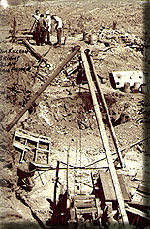 |
|
||
|
|||
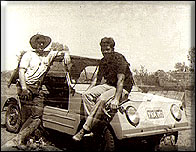 Alan's
dad was a parttime prospector and miner in the tin and woflram
fields of North Queensland in his youth. However, it was not
until Alan met and worked with Brian Speechley at Mount Isa
Mines in the 1960s that his interest in prospecting and mining
was kindled. Alan started out sweeping the floors in the electrical
workshop at Mount Isa Mines and finished up in Mine Planning
& Design.
Alan's
dad was a parttime prospector and miner in the tin and woflram
fields of North Queensland in his youth. However, it was not
until Alan met and worked with Brian Speechley at Mount Isa
Mines in the 1960s that his interest in prospecting and mining
was kindled. Alan started out sweeping the floors in the electrical
workshop at Mount Isa Mines and finished up in Mine Planning
& Design. 